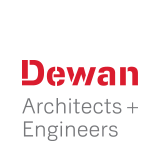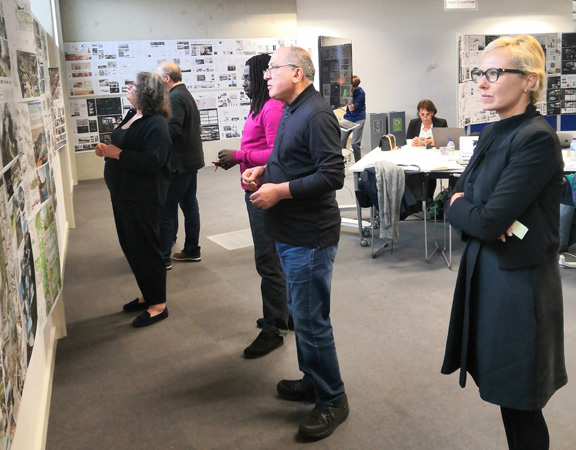Dewan Architects + Engineers is delighted to announce the winner of its Dewan Award for Architecture 2019. The award, held in partnership with Tamayouz Excellence Award, is an annual thematic prize that calls on participants from around the world to respond to Iraq-specific issues.
This year, the award’s theme was the regeneration of Al Umma Park in Baghdad, seeking proposals that were mindful of the existing structures and artworks in the park, as well as the demands of the community and local context.
The first prize winner for the Dewan Award for Architecture is Tha’er Qub’a Architects from Amman, Jordan. Second prize goes to 2X1 Architects from Ankara, Turkey and third prize is Marcin Kitala from Czestochowa, Poland. The Dewan Award also recognises seven honourable mentions.
The winners and honourable mentions were selected by Tamayouz’s jury members, who met in October 2019 at Coventry University in the UK. The panel members were:
-
Mohamed Al-Assam, Founder and executive chairman of Dewan Architects + Engineers; Dubai, UAE
-
Dr. Jala Makhzoumi, AUB academic and president of the Landscape Association in Lebanon; Beirut, Lebanon
-
Professor Kostas Adamakis, Architect, University of Thessaly academic and former Deputy Mayor of Volos; Volos, Greece
-
Dr. Wendy Pullan, University of Cambridge academic; Cambridge, United Kingdom
-
Dr. Carl Fraser, Coventry University academic and researcher; Coventry, United Kingdom
-
Kathy Basheva, RIBA chartered architect and founder of Studio Basheva; London, United Kingdom
The winners were selected from a shortlist of 20 submissions, which was released in September 2019. The shortlisted finalists were chosen from a larger pool of 99 submissions from 29 countries. Selection of the finalists was based off criteria set in the award’s brief, such as responding to the site’s conditions and offering solutions that are mindful of the park’s existing structures and monuments, as well as the needs of the local context and community. To read about the other finalists for the Dewan Award for Architecture, please visit Tamayouz’s website.
The winner and finalists will be celebrated during Tamayouz Excellence Award’s annual ceremony held on 7 December, 2019 in Amman, Jordan.
First prize - Tha'er Qub'a Architects; Amman, Jordan
“This project shows clear interaction and engagement with the park’s existing monuments, while the mural reverberates throughout the design. The bridge links provide a strong lateral connection that interrelates with the neighbouring context. We found the approach to the regeneration repetitive yet varied, which creates an interesting play in rectilinearity.
“The project’s response to climatic requirements is appropriate and avoids large expanses of lawn areas, integrating a low-management approach to the site. The architects employed simple, direct and reliable solutions that suit the scale of the site, while also creating a balance between soft and hardscape, with an intelligent use of plains. The bustan/orchard gives a strong sense of place in Baghdad and the wider Middle East, while the well-scaled, tree-lined streets would be appealing to pedestrians flanking the long sides of the park.
“We commend the clear methodology, concept development and design logic of the project.”

Second prize - 2x1 Architects (Hakan Evkaya and Kutlu İnanç Bal); Ankara, Turkey
“This project exhibits an appropriateness of scale with spaces that are truly inhabited with a diversity of activities. The strong urban design considers the city in which the project will exist, and it’s clear that keen attention has been paid to horticulture and sustainability, especially through the incorporation of technologies that are climatically and culturally relevant.
“The architects managed a great interface with the edge of the site, exhibiting skilled negotiation between the park and the city. We also found that the key structure, or spine, further facilitates a diverse linearity of experiences – which is very much welcome.
“This project would have benefited from keeping the spine open at its potential interface with Tahrir Square.”

Third prize - Marcin Kitala; Czestochowa, Poland
“This project provides a system to break down the large spaces into garden-rooms, which align with the urban surroundings. We found the project to be a refreshing and original concept for the site, communicated through a beautifully presented submission.
“The egalitarian approach to the design makes use of a detailed and varied green carpet, while diversity of horticulture is a strength of the project. Connectivity with the existing edge of the site is also addressed well. We appreciated the feasibility of the project, and find it implementable.
“However, the project lacks a diversity of spaces, and focuses heavily on the garden areas. We find the proposal could have benefited from balancing this out.”

Honourable Mentions:
*Arranged in alphabetical order
Adriano Marin Perez; Barcelona, Spain
“The starting point of the concept, which centres on regenerating a new green and dynamic public space, is commendable. The designer suggested the division of the park into circular gardens of various sizes and characters, with each of these oases having their own flora, fauna, water arrangement and shading – something we commend. We also appreciate a landscape design based on native species, such as palm trees and low-growing vegetation. However, the overall proposal could have benefited from incorporating a traffic proposal and further connecting the green islands with the dense urban fabric at the heart of Baghdad.”

Ali Habibianfar and Parisa Davoudi; London, UK
“This proposal is an innovative and bold approach that suggests the demolishing of the one urban block on the Tigris riverside and designing a pedestrian pathway connected to the bridge, which links Al Umma Park to the west of the Tigris River. The design creates an integrated and continuous public space across the bridge, and highlights the river as “the only constant” in Baghdad’s turbulent history. However, translating this idea into a spatial reality requires further development. The abrupt lowering and raising of the sizeable buildings create functional discrepancies to the free space of the park. Additionally, the proposal did not address the traffic of the surrounding streets, the underground metro and the Al Umma Cultural Centre.”

Della Gondola (Sulev Nurme, Sten Juur and Anna Belova); Tartu, Estonia
“The design concept is simple and implementable, with the project’s connections via the urban edges well-thought through, layered and detailed. The project’s underground design is successful, and it features a very interesting design of Al Umma Cultural Centre. We also commend the diagrammatic representation of the proposal, which incorporates the two squares in the plot of the park, as well as the traffic connection with the urban fabric. However, the architectural treatment of the required building appears a bit exaggerated and out of scale with the surroundings.”

Hamdy Hefnawy, Mennatullah Ezzat and Ahmed Sayed Mostafa Abdelgafar; Cairo, Egypt
“This entry featured an innovative interweaving approach of the park with its urban context. It features a strong concept and sensitive design that successfully integrates the garden with the surrounding urban fabric. The architects’ elaboration of the concept is also commendable. However, while the shape of the cultural centre is interesting, it is massive in relation to the total area and it overshadows the Freedom Monument. Also, the project would have benefited from incorporating plans for the underground metro connection, parking area and traffic rearrangement of the surrounding streets.”

Hebah Qatanany; Dubai, UAE
“This entry offered an excellent presentation, with great diagrams of the concept’s explanation. The transversal sections completely clarify the placing of Al Umma Cultural Centre in relation with the context. The concept of a ‘chasm’ that cuts through the site is interesting, as are the layers of elevated green spaces, mounds and the street level with urban connections. However, the triangular forms are overused, and disassociated from the orthogonal character of the surrounding urban character. Also, the proposal does not provide a traffic proposal.”

Spot: Badr Ahmad and Nizar R. J. Dalfi; Baghdad, Iraq
“The aim of creating or rehabilitating Al Umma Park is stressed in this design, which has been translated into a more realistic design. Sinking the garden and extending the sidewalk edges so they cantilever over the garden is very clever, as is the coloured overhead shading. We are pleased with the artistic and joyful ‘calligraphic’ approach of this proposal, which illustrates the architect’s research of Iraq’s history and culture. However, the design lacks spatial definition and doesn’t address surrounding traffic, parking or place for athletic activities.”

Zeinab Muneam; Frankfurt, Germany
“This proposal features an excellent elaboration of its strategy for traffic design, and incorporates the correct enrolment of the nearby plot. We found the design to be simple and realistic, and successful in addressing the competition requirements. Connections to the Museum of Modern Art and the metro station are well-integrated into the design. However, the internal pedestrian pathway is not suitable for the natural environment of the park. Also, it wasn’t clear where and how concrete barriers would be reused, although this is a highlighted element in the proposal.”

The Dewan Award for Architecture is named after Dewan Architects + Engineers, one of the world’s most established and leading architecture firms, particularly to emerge from the Middle East. It is a joint prize held in partnership between Tamayouz and Dewan. Seeking regional and international proposals, the award aims to recognise design solutions that respond to local challenges in Iraq.
For its inaugural theme in 2018, the award sought proposals for a school in Iraq’s marshlands. Information about previous winners can be found here.
Tamayouz Excellence Award is sponsored by Coventry University, the Iraqi Business Council in Jordan, Kufa – Makiya Charity, Dewan Architects + Engineers, Ayad Al-Tuhafi Architects, Bonair Ltd, the United Nations Global Compact – Iraq Network.


